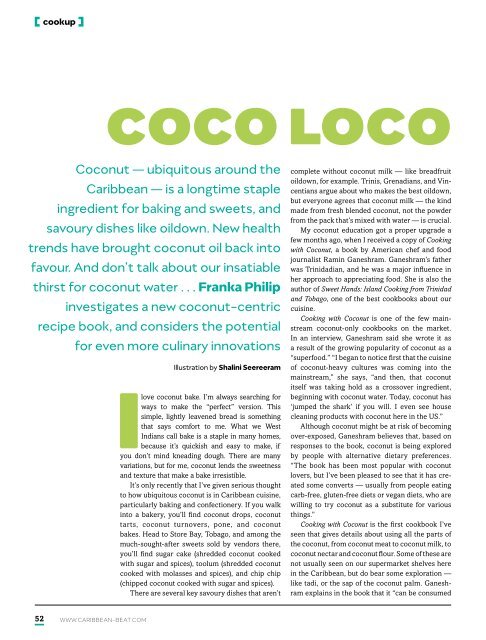Caribbean Beat — January/February 2019 (#155)
A calendar of events; music, film, and book reviews; travel features; people profiles, and much more.
A calendar of events; music, film, and book reviews; travel features; people profiles, and much more.
Create successful ePaper yourself
Turn your PDF publications into a flip-book with our unique Google optimized e-Paper software.
cookup<br />
Coco loco<br />
Coconut <strong>—</strong> ubiquitous around the<br />
<strong>Caribbean</strong> <strong>—</strong> is a longtime staple<br />
ingredient for baking and sweets, and<br />
savoury dishes like oildown. New health<br />
trends have brought coconut oil back into<br />
favour. And don’t talk about our insatiable<br />
thirst for coconut water . . . Franka Philip<br />
investigates a new coconut-centric<br />
recipe book, and considers the potential<br />
for even more culinary innovations<br />
Illustration by Shalini Seereeram<br />
I<br />
love coconut bake. I’m always searching for<br />
ways to make the “perfect” version. This<br />
simple, lightly leavened bread is something<br />
that says comfort to me. What we West<br />
Indians call bake is a staple in many homes,<br />
because it’s quickish and easy to make, if<br />
you don’t mind kneading dough. There are many<br />
variations, but for me, coconut lends the sweetness<br />
and texture that make a bake irresistible.<br />
It’s only recently that I’ve given serious thought<br />
to how ubiquitous coconut is in <strong>Caribbean</strong> cuisine,<br />
particularly baking and confectionery. If you walk<br />
into a bakery, you’ll find coconut drops, coconut<br />
tarts, coconut turnovers, pone, and coconut<br />
bakes. Head to Store Bay, Tobago, and among the<br />
much-sought-after sweets sold by vendors there,<br />
you’ll find sugar cake (shredded coconut cooked<br />
with sugar and spices), toolum (shredded coconut<br />
cooked with molasses and spices), and chip chip<br />
(chipped coconut cooked with sugar and spices).<br />
There are several key savoury dishes that aren’t<br />
complete without coconut milk <strong>—</strong> like breadfruit<br />
oildown, for example. Trinis, Grenadians, and Vincentians<br />
argue about who makes the best oildown,<br />
but everyone agrees that coconut milk <strong>—</strong> the kind<br />
made from fresh blended coconut, not the powder<br />
from the pack that’s mixed with water <strong>—</strong> is crucial.<br />
My coconut education got a proper upgrade a<br />
few months ago, when I received a copy of Cooking<br />
with Coconut, a book by American chef and food<br />
journalist Ramin Ganeshram. Ganeshram’s father<br />
was Trinidadian, and he was a major influence in<br />
her approach to appreciating food. She is also the<br />
author of Sweet Hands: Island Cooking from Trinidad<br />
and Tobago, one of the best cookbooks about our<br />
cuisine.<br />
Cooking with Coconut is one of the few mainstream<br />
coconut-only cookbooks on the market.<br />
In an interview, Ganeshram said she wrote it as<br />
a result of the growing popularity of coconut as a<br />
“superfood.” “I began to notice first that the cuisine<br />
of coconut-heavy cultures was coming into the<br />
mainstream,” she says, “and then, that coconut<br />
itself was taking hold as a crossover ingredient,<br />
beginning with coconut water. Today, coconut has<br />
‘jumped the shark’ if you will. I even see house<br />
cleaning products with coconut here in the US.”<br />
Although coconut might be at risk of becoming<br />
over-exposed, Ganeshram believes that, based on<br />
responses to the book, coconut is being explored<br />
by people with alternative dietary preferences.<br />
“The book has been most popular with coconut<br />
lovers, but I’ve been pleased to see that it has created<br />
some converts <strong>—</strong> usually from people eating<br />
carb-free, gluten-free diets or vegan diets, who are<br />
willing to try coconut as a substitute for various<br />
things.”<br />
Cooking with Coconut is the first cookbook I’ve<br />
seen that gives details about using all the parts of<br />
the coconut, from coconut meat to coconut milk, to<br />
coconut nectar and coconut flour. Some of these are<br />
not usually seen on our supermarket shelves here<br />
in the <strong>Caribbean</strong>, but do bear some exploration <strong>—</strong><br />
like tadi, or the sap of the coconut palm. Ganeshram<br />
explains in the book that it “can be consumed<br />
52 WWW.CARIBBEAN-BEAT.COM


















